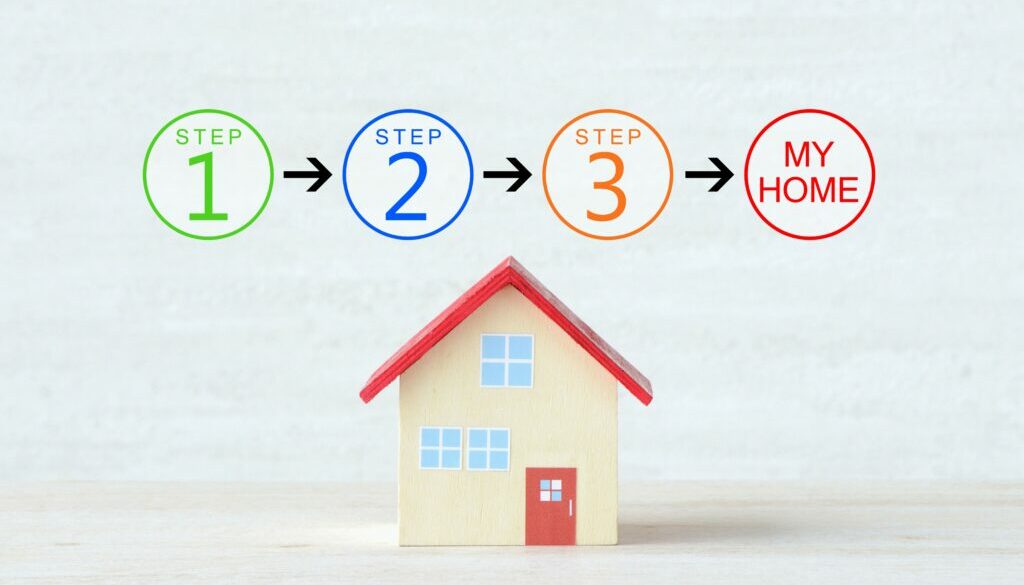The Mortgage Loan Process: A Step-by-Step Guide
The mortgage loan process involves several steps, including pre-qualification, application, underwriting, and closing. Here’s a brief overview of each step:
- Pre-qualification. This is the initial step where you determine how much you can afford to borrow based on your income, credit score, and debt-to-income ratio. You can get pre-qualified by submitting basic information to a lender, such as your income, assets, and debts.
- Application. Once you are pre-qualified, you can begin the mortgage loan application process by providing detailed information to the lender. This includes your employment history, income documentation, and a list of your assets and liabilities.
- Underwriting. The lender will verify the information you provided and will evaluate your creditworthiness to determine whether you qualify for the loan. They will also order an appraisal to assess the value of the property you want to purchase.
- Closing. If you are approved for the loan, you will receive a loan commitment letter, and you can move on to the closing process. At closing, you will sign the loan documents, pay any closing costs, and receive the keys to your new home.
How long does the mortgage loan process take?
In general, the mortgage loan process typically takes around 14 to 45 days from the time you submit your application to the time you close on your loan. In some situations, depending on various factors, the process can take from a couple of weeks to several months. Some of the factors that can affect the timeline include:
- The type of loan you are applying for: Some types of loans, such as FHA or USDA loans, can take longer to process than others.
- The complexity of your financial situation: If you have a complicated financial history or if there are issues with your credit report, the process may take longer.
- The availability of documentation: If you are missing documents or if the lender needs additional information from you, it can delay the process.
- The housing market: If there is a high demand for homes, it may take longer to process your loan because there are more applicants.
What is the interest rate lock and when do I lock it?
An interest rate lock is an agreement between you and your lender that locks in a specific interest rate for a certain period of time. This means that your interest rate will not change during that time, even if market rates increase. The interest rate lock helps protect you against rising interest rates while your mortgage loan is being processed.
You can typically lock in an interest rate at any time during the mortgage loan process, but many borrowers choose to do so after they have completed the loan application and have a good idea of their creditworthiness and the terms of the loan.
The length of time you can lock in your interest rate will vary depending on the lender and your situation, but it typically ranges from 30 to 60 days. You will want to make sure that your interest rate lock period is long enough to cover the entire processing time for your loan, including underwriting, appraisal, and closing.
There may be fees associated with locking in an interest rate, and these fees can vary depending on the lender and the length of the lock period. You should ask your lender about any fees and make sure you understand the terms of the rate lock agreement before agreeing to lock in your rate.
Once you have locked in your interest rate, it is important to closely monitor the expiration date of your rate lock agreement. If your loan is not ready to close by the expiration date, you may need to request an extension or re-lock your rate, which could result in additional fees.
What documents do I need to provide for a mortgage loan?
To apply for a mortgage loan, you will need to provide various documents to your lender. The specific documents required may vary depending on the details of your situation and the type of loan you are applying for. Here are some of the most common documents you will need:
- Proof of income. This includes your most recent pay stubs, W-2 forms, and tax returns from the past two years.
- Bank statements. You will need to provide bank statements for the past two to three months to show proof of funds and verify your down payment.
- Employment verification. Your lender may need to verify your employment history and current job status.
- Identification. You will need to provide a government-issued ID, such as a driver’s license or passport.
- Credit report. Your lender will run a credit report to assess your creditworthiness.
- Purchase agreement. If you are buying a home, you will need to provide an executed purchase agreement.
- Homeowners insurance. You will need to provide proof of homeowners’ insurance before closing.
- Gift letter. If you are receiving a gift for your down payment, you will need to provide a gift letter signed by the person giving you the gift.
- Additional documentation. Depending on your financial situation, your lender may request additional documentation, such as divorce decrees or child support agreements.
Work closely with your lender to ensure that you provide all the necessary documentation and that it is complete and accurate. This can help streamline the mortgage loan process and increase your chances of approval.
What do mortgage loan underwriters look at?
The underwriting part of the mortgage process typically takes between 1 to 2 weeks, but it can take longer in some cases. The exact timeline depends on several factors, including the complexity of your financial situation, the type of loan you’re applying for, and the lender’s workload.
Mortgage loan underwriters evaluate various factors to determine whether a borrower is eligible for a mortgage loan. Here are some of the key things that underwriters look at:
- Credit history. Underwriters review your credit score and credit history to assess your creditworthiness. They will look at your payment history, outstanding debts, and any late payments or delinquencies.
- Income and employment. Underwriters will verify your income and employment history to ensure that you have a stable source of income to repay the loan.
- Debt-to-income ratio. Underwriters calculate your debt-to-income (DTI) ratio by comparing your monthly debt payments to your monthly income. A lower DTI ratio generally indicates that you are less of a credit risk.
- Assets. Underwriters may review your assets, such as savings accounts or investments, to determine whether you have sufficient funds to cover the down payment and closing costs.
- Property appraisal. Underwriters order a property appraisal to ensure that the home you are purchasing is worth the amount you are borrowing.
The underwriting process is designed to assess your ability to repay the loan and to mitigate the lender’s risk. By reviewing all of these factors, underwriters can make an informed decision about whether to approve your mortgage loan application.
What happens if I am not qualified?
If you are not qualified for a mortgage loan, it means that the lender has determined that you do not meet their requirements for creditworthiness or income. Depending on the reason why you are not qualified, there are a few potential outcomes:
- Rejection: If you are not qualified due to a low credit score, high debt-to-income ratio, or other financial factors, the lender may reject your application outright. In this case, you will need to work on improving your credit and financial situation before applying for a mortgage loan again in the future.
- Counteroffer: If you are not qualified for the loan amount you requested, the lender may offer a smaller loan amount or less favorable terms. This could include a higher interest rate, a longer loan term, or a larger down payment requirement.
- Conditional approval: In some cases, the lender may offer a conditional approval, which means that you are approved for the loan pending the resolution of certain conditions. For example, you may need to provide additional documentation, pay off certain debts, or make improvements to the property you are purchasing.
If you are not qualified for a mortgage loan, it is essential to understand the reasons why and take steps to address any issues that may be holding you back. You may want to work with a financial advisor or credit counselor to improve your credit and financial situation, or consider alternative financing options such as a smaller loan amount or a cosigner.
A cosigner is someone who agrees to take responsibility for the mortgage loan if you are unable to make the payments. The cosigner’s income and credit history are taken into consideration along with yours to determine your eligibility for the loan.
You may want to consider getting a cosigner if you have a high debt-to-income ratio or other financial issues that make it difficult to qualify for a mortgage loan on your own. A cosigner with a strong credit score and income can help improve your chances of being approved for a loan and may also help you qualify for better interest rates and terms.
Having a cosigner also comes with risks. If you are unable to make the payments on the loan, the cosigner will be responsible for making the payments. This can damage their credit and financial situation, and strain your relationship with the cosigner.
How and when does the closing happen?
The closing is the final step in the mortgage loan process. It is where you will sign all the necessary documents and pay any remaining closing costs and fees. Here’s how the closing typically works:
- Closing disclosure. You will receive a closing disclosure at least three days before the closing date. This document outlines the final terms and costs of your loan.
- Review documents. On the day of the closing, you will meet with a closing agent or attorney who will explain all of the documents you need to sign. Be sure to review each document carefully before signing.
- Payment. You will need to bring a cashier’s check or arrange for a wire transfer to pay any remaining closing costs and fees.
- Title transfer. The closing agent or attorney will ensure that the title of the property is transferred from the seller to you.
- Mortgage note and deed of trust. You will sign the mortgage note and the deed of trust, which outline the terms of your loan and the collateral securing the loan.
- Property deed. You will receive the property deed, which officially transfers ownership of the property to you.
- Final closing statement. You will receive a closing statement that summarizes all of the costs and fees associated with the loan.
Once all of the necessary documents have been signed and payments made, the closing agent or attorney will record the mortgage and deed with the county recorder’s office. The loan funds will then be disbursed to the seller, and you will officially become the owner of the property.
The closing process can take up to several hours, so it is important to be prepared and ask any questions you have along the way.
Bottom Line
Mortgage loan process refers to the steps taken by lenders to evaluate and approve your loan application. The processing time can vary, but typically takes around 30-45 days. It involves verifying your financial information, ordering property appraisals, and assessing your creditworthiness. Throughout the process, you will need to work closely with your lender and provide any0 information or documentation they request. It is crucial to provide all required documentation promptly to avoid time delays and unnecessary frustration. It is essential to understand the terms and conditions of the loan and to read all the documents carefully before signing. Familiarize yourself with the process and ask as many questions as you need before getting started on your mortgage loan. Reach out to me for any additional guidance at 312-296-4175 or email me at connect@borislending.com. I lend in all 50 states and I am never too busy for your referrals!!
I have been in the mortgage industry since 1997 and I understand the anxiety that comes with making the most expensive investment of a lifetime. My objective is to be your advisor, to educate you and to make the mortgage loan transaction as transparent and as stress-free as possible. I enjoy establishing personal connections and work mostly by referral. I thoroughly explain the process and available options, and guide my clients to make choices that best fit their needs and financial goals. Once the underwriting begins I communicate regularly and keep my clients apprised of the loan status from the beginning through the end. My relationship with clients does not end at the closing table. You are my client for life and I am always available to answer your questions and provide you with guidance.




